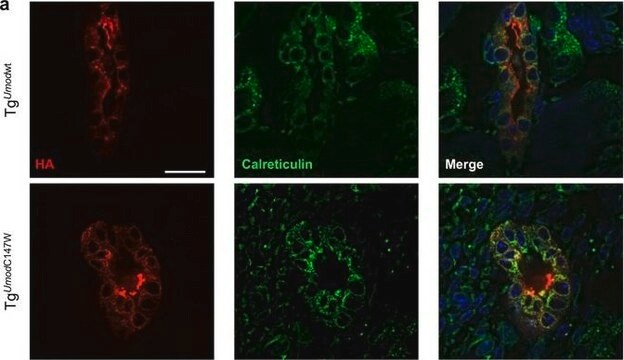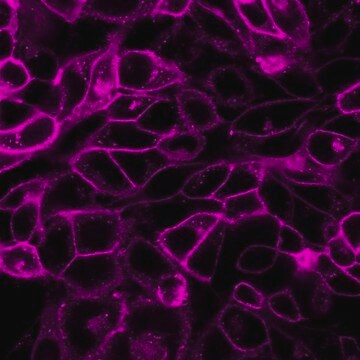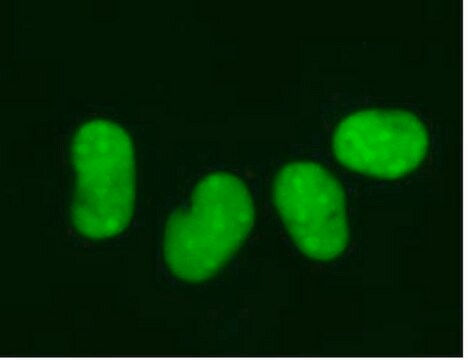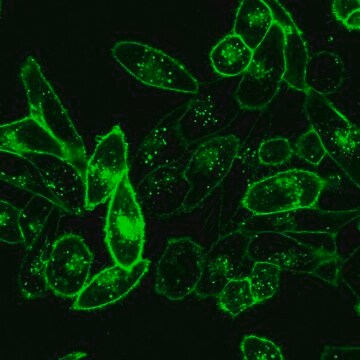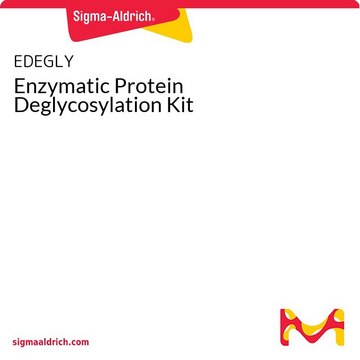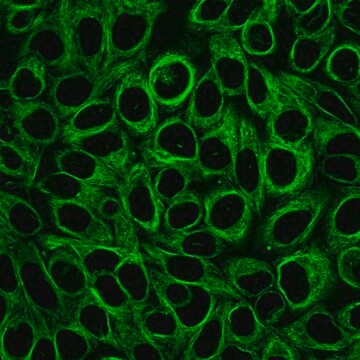17-10146
LentiBrite Calreticulin-RFP-KDEL Lentiviral Biosensor
Sinonimo/i:
Endoplasmic reticulum resident protein 60, Calregulin
About This Item
Prodotti consigliati
Produttore/marchio commerciale
Chemicon®
LentiBrite
Livello qualitativo
tecniche
cell based assay: suitable
immunocytochemistry: suitable
immunofluorescence: suitable
transfection: suitable
N° accesso UniProt
Metodo di rivelazione
fluorometric
Condizioni di spedizione
dry ice
Informazioni sul gene
human ... CALR(811)
Descrizione generale
http://www.nature.com/app_notes/nmeth/2012/121007/pdf/an8620.pdf
(Click Here!)
Learn more about the advantages of our LentiBrite Lentiviral Biosensors! Click Here
Biosensors can be used to detect the presence/absence of a particular protein as well as the subcellular location of that protein within the live state of a cell. Fluorescent tags are often desired as a means to visualize the protein of interest within a cell by either fluorescent microscopy or time-lapse video capture. Visualizing live cells without disruption allows researchers to observe cellular conditions in real time.
Lentiviral vector systems are a popular research tool used to introduce gene products into cells. Lentiviral transfection has advantages over non-viral methods such as chemical-based transfection including higher-efficiency transfection of dividing and non-dividing cells, long-term stable expression of the transgene, and low immunogenicity.
EMD Millipore is introducing LentiBrite Lentiviral Biosensors, a new suite of pre-packaged lentiviral particles encoding important and foundational proteins of autophagy, apoptosis, and cell structure for visualization under different cell/disease states in live cell and in vitro analysis.
- Pre-packaged, fluorescently-tagged with GFP & RFP
- Higher efficiency transfection as compared to traditional chemical-based and other non-viral-based transfection methods
- Ability to transfect dividing, non-dividing, and difficult-to-transfect cell types, such as primary cells or stem cells
- Non-disruptive towards cellular function
EMD Millipore’s LentiBrite Calreticulin-RFP-KDEL lentiviral particles provide bright fluorescence and precise localization to enable live cell analysis of autophagy in difficult-to-transfect cell types.
EMD Millipore’s LentiBrite Calreticulin-RFP-KDEL lentiviral particles provide bright fluorescence and precise localization to enable live cell analysis of calreticulin dynamics in difficult-to-transfect cell types.
Applicazioni
(See Figure 1 in datasheet)
U2OS cells were plated in a chamber slide and transduced with lentiviral particles at an MOI of 5 for 24 hours. After media replacement and 48 hours further incubation, cells were fixed with formaldehyde and mounted. Images were obtained by oil immersion wide-field fluorescence microscopy.
The calreticulin-RFP-KDEL appears in a meshwork pattern in the cytoplasm.
Immunocytochemistry Comparison and Inhibitor Analysis:
(See Figure 2 in datasheet)
Similar to Figure 1, HeLa cells were plated in a chamber slide and transduced with lentiviral particles at an MOI of 40 for 24 hours. After 24 hours, media was replaced and cells were then further incubated for 48 hours. Immunocytochemical staining (green) of the same fields of view with a polyclonal antibody against calreticulin reveals similar expression patterns to the RFP-protein (red).
Hard-to-transfect Cell Types:
(See Figure 3 in datasheet)
Primary cell types HUVEC and HuMSC were plated in chamber slides and transduced with lentiviral particles at an MOI of 40 and 10 respectively for 24 hours.
Additional Cell Type:
(See Figure 4 in datasheet)
HT1080 and REF52 cells were treated as in Figure 1.
For optimal fluorescent visualization, it is recommended to analyze the target expression level within 24-48 hrs after transfection/infection for optimal live cell analysis, as fluorescent intensity may dim over time, especially in difficult-to-transfect cell lines. Infected cells may be frozen down after successful transfection/infection and thawed in culture to retain positive fluorescent expression beyond 24-48 hrs. Length and intensity of fluorescent expression varies between cell lines. Higher MOIs may be required for difficult-to-transfect cell lines.
Apoptosis & Cancer
Apoptosis - Additional
Componenti
One vial containing 25 µL of lentiviral particles at a minimum of 3 x 10E8 infectious units (IFU) per mL.
For lot-specific titer information, please see “Viral Titer” in the product box above.
Promoter
EF-1 (Elongation Factor-1)
Multiplicty of Infection (MOI)
MOI = Ratio of # of infectious lentiviral particles (IFU) to # of cells being infected.
Typical MOI values for high transduction efficiency and signal intensity are in the range of 20-40. For this target, some cell types may require lower MOIs (e.g., HT-1080, HeLa, U2OS), while others may require higher MOIs (e.g., human mesenchymal stem cells (HuMSC), human umbilical vein endothelial cells (HUVEC)).
NOTE: MOI should be titrated and optimized by the end user for each cell type and lentiviral target to achieve desired transduction efficiency and signal intensity.
Qualità
Stato fisico
Stoccaggio e stabilità
Lentivirus is stable for at least 4 months from date of receipt when stored at -80°C. After first thaw, place immediately on ice and freeze in working aliquots at -80°C. Frozen aliquots may be stored for at least 2 months. Further freeze/thaws may result in decreased virus titer and transduction efficiency.
IMPORTANT SAFETY NOTE
Replication-defective lentiviral vectors, such as the 3rd Generation vector provided in this product, are not known to cause any diseases in humans or animals. However, lentiviruses can integrate into the host cell genome and thus pose some risk of insertional mutagenesis. Material is a Risk Group 2 and should be handled under BSL2 controls. A detailed discussion of biosafety of lentiviral vectors is provided in Pauwels, K. et al. (2009). State-of-the-art lentiviral vectors for research use: Risk assessment and biosafety recommendations. Curr. Gene Ther. 9: 459-474.
Note legali
Codice della classe di stoccaggio
10 - Combustible liquids
Classe di pericolosità dell'acqua (WGK)
WGK 2
Certificati d'analisi (COA)
Cerca il Certificati d'analisi (COA) digitando il numero di lotto/batch corrispondente. I numeri di lotto o di batch sono stampati sull'etichetta dei prodotti dopo la parola ‘Lotto’ o ‘Batch’.
Possiedi già questo prodotto?
I documenti relativi ai prodotti acquistati recentemente sono disponibili nell’Archivio dei documenti.
Il team dei nostri ricercatori vanta grande esperienza in tutte le aree della ricerca quali Life Science, scienza dei materiali, sintesi chimica, cromatografia, discipline analitiche, ecc..
Contatta l'Assistenza Tecnica.